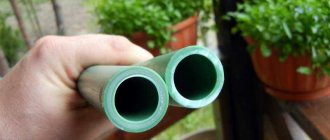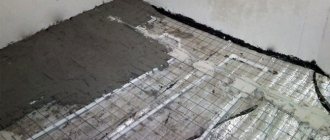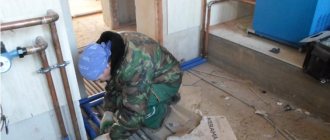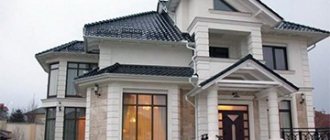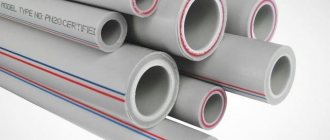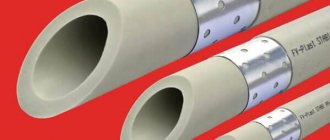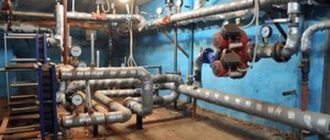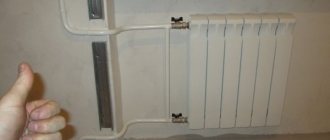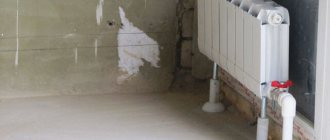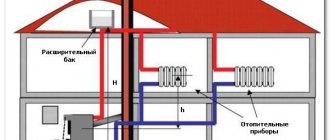What temperature can polypropylene pipes withstand?
To determine the purpose of a polypropylene pipe by appearance, there is a special marking. In addition to the manufacturer and brand name, the generally accepted classification is applied to the pipe.
- name of modification of polypropylene;
- standard proportional ratio;
- nominal outer diameter and wall thickness;
- nominal pressure;
- manufacturer's standards.
The maximum temperature of PP pipes is 95° C. This is perhaps the only drawback of polypropylene; it cannot withstand high temperatures. At 140° the material becomes soft and easily deforms, and at 175° it melts.
The temperature in heating systems is also not designed for such indicators, so PP pipes are quite suitable for use for heat pipes.
Short-term increases in temperature rarely lead to failure, but it is important to take into account that operating pipes at temperatures of 100° significantly reduces their service life.
The 50 years declared by the manufacturer can actually turn into a year and a half, because durability depends not only on its technical characteristics, but also on operating conditions.
We recommend that you read: Polypropylene pipes and their sizes: how parameters affect the operation of the system
Types of polypropylene pipes
Polypropylene pipes are divided into two main types: reinforced or unreinforced . They are also divided according to their layout and material of manufacture. If the product has a blue stripe, then it is recommended for cold water supply, and a red one for hot water supply.
Products made of polypropylene of any type are marked with the letters PN. The number next to the abbreviation PN affects the cost, and accordingly, the larger it is, the higher the price.
Polypropylene and Heating? It makes sense?
unreinforced
The purpose of non-reinforced types is cold water lines. They are not suitable for hot water supply, since when heated, the pipeline can lengthen - every 10 meters by 150 mm, which will cause it to rupture. Although, in low-temperature structures, installation of unreinforced models is possible, but only if the pressure is not high.
Such types have increased flexibility, ductility and low cost. Conventional profiles are easy to install, since the connection areas with the fitting are free of obstacles.
The following markings are placed on polypropylene products, which indicate the permissible maximum temperature:
- PN 10 - permissible temperature + 45 (for floor heating) and + 20 (for water supply), pressure 1 MPa. Wall thickness - 10 mm, diameter - from 20 to 110 mm.
- PN 16 - permitted pressure 1.6 MPa, temperature value + 60. Wall thickness from 3.4 mm.
- PN 20 - permissible pressure of 2 MPa, at a temperature of + 80 degrees. Wall thickness 16 - 18.4 mm.
The service life of unreinforced mains when used in cold water supply reaches 50 years, 30 years if heated coolant moves through them.
Reinforced
Reinforcement - the presence of an additional aluminum or fiberglass layer. This material makes the product stronger, increases its service life, even in the presence of hot coolant, the profile will last up to 50 years.
In addition, reinforcement allows the use of this pipeline with water heated to + 120 degrees, without the risk that linear expansion will occur, with further rupture of the line.
The purpose of models with reinforcement is hot water supply with high pressure. This type:
- more resistant to chemicals;
- its expansion coefficient is 5 times lower than the usual profile;
- ability to withstand high temperatures and maximum loads.
According to the reinforcement material, profiles are:
- With an aluminum layer - these models have a high operating pressure level, so they are suitable for central heating and hot water. The aluminum layer reduces the degree of thermal deformation and oxygen diffusion.
Installation of an aluminum-reinforced profile is difficult, since contact of the aluminum layer with water is not allowed. Therefore, the joints must be cleared of a few centimeters of the reinforcing coating.
- Fiberglass reinforced - have a low level of expansion. Fiberglass fiber reduces deformation when heated. Compared to aluminum models, such products have a lower heating pressure, so they are less in demand.
The installation process of this type is simpler, because no stripping is required. Fiber fibers are connected to each other with molten polyethylene, and there is no delamination of the material.
- Pipes reinforced with basalt fiber. This type has a lot of advantages, compared not only with any reinforced models, but also with profiles made of plastic and metal. It is easier to install compared to aluminum coating, since there is no need to strip it. Basalt products are easily connected to any types of polypropylene fittings.
Reinforced pipes are marked PN 20 and PN 25. They are able to withstand temperatures of + 95 and pressures of up to 2.5 MPa.
But not all reinforced products are able to withstand higher degrees of heating. For example, aluminum ones cannot withstand the temperature that a fiberglass-reinforced polypropylene pipe can withstand - + 120 (although also not for a long time).
Pressure and temperature
The manufacturer determines the service life of a polypropylene pipe to be 50 years. The pressure level and temperature of the working environment are important indicators on which the durability and reliability of polypropylene pipes depends.
The higher t, the lower the pressure level should be. The permissible pressure for operating a PP pipe is 30 kg/cm2, but such indicators at high pressure can be critical. In polypropylene pipes, the operating pressure level should still not exceed 10 kg/cm2.
Important! Ideal conditions for PP pipes to serve as long as possible are that the temperature of the liquid should not be higher than 70° at a pressure of 4-6 atmospheres.
Standards for polypropylene tubes
When choosing polypropylene pipes for heating, you need to know what standards such pipes have and what the pipe material “polypropylene” is.
Pressure
The operating pressure of a plastic tube is indicated by the following marking - PN**. Instead of asterisks, numbers are written on pipeline products indicating the maximum operating pressure that a plastic tube can withstand - in atmospheres.
- LiveJournal
- Blogger
Diagram of the internal structure of a polypropylene pipe
The installer or apartment owner should keep in mind that the operating pressure of a plastic pipe product is indicated for a temperature of 20 degrees Celsius.
At 80–90 degrees Celsius, the operating pressure of the tube must be divided by 3. As a result, professionals in this matter advise buying PN25 polypropylene pipes.
Temperature
The maximum operating temperature of the plastic tube is 95 degrees Celsius. However, the optimal temperature is 90 degrees Celsius.
In such a situation, the heating temperature in the residential premises is set to room temperature, and the manufacturer of plastic pipes prevents the consumer from filing a lawsuit against him regarding the deformation of the pipe product.
Diameter
When calculating the diameter of a plastic tube, workers use complex formulas. Such formulas contain indicators such as: thermal load, polypropylene roughness coefficient, etc.
However, in practice, installers use the following 2 rules:
- When installing a plastic heating pipeline system in an apartment, the pipe products used should not reduce the clearance relative to the risers.
In new buildings, installers install pipe risers DN20 (¾ inch). In such a situation, the installer installs a heating piping system in the apartment made of plastic tubes, the outer diameter of which is 26 mm.
In stalinkas, in which there are inch risers, workers install plastic pipe products, the outer diameter of which is 32 mm;
- if plastic tubes are installed in a house whose area does not exceed 250 square meters. m, then in such a situation the installers bring such a reliable heating system to the house - Leningradka.
In such a situation, installers install pipeline rings and cut in radiators - heating devices.
For the ring, a plastic tubular product is used, the diameter of which is 32-40 mm, for inserting radiators - 20-26 mm, respectively.
- LiveJournal
- Blogger
Plastic pipe products in different sizes
Why do you need pipe reinforcement?
To ensure a sufficient level of heat in apartments, it is necessary to turn on the return pipeline and increase the water temperature to 10 ° C. At close operating temperatures, simple polypropylene pipes begin to lose their properties and, in addition, a linear expansion of their dimensions is possible.
This is especially important when laying pipelines with high temperatures in a concrete screed. There is a possibility of concrete cracking and breakdown of the entire heating system. To reduce this effect and completely eliminate it, polypropylene pipes are reinforced.
Reinforcement is the strengthening of the load-bearing capacity of the base material of a product with another material that has a higher level of strength. This increases the ability to withstand temperature changes. Reinforced pipes fully comply with the standards of the heating system, and do not deform when it increases significantly.
The following materials are used to reinforce polypropylene pipes:
- aluminum foil applied to the surface;
- the inner layer of aluminum located along the entire diameter of the pipe, closer to the outer surface;
- fiberglass inner layer;
- inner layer combining fiber and glass fibers.
Aluminum and fiberglass cost about the same. The price mainly depends on the parameters of the pipe itself and the manufacturer. Nevertheless, fiberglass reinforcement has a number of advantages over aluminum:
- no cleaning of the pipe edge is required during installation;
- short time for soldering joints (as with unreinforced pipes);
- there is no internal delamination due to the fusion of glass fiber into polypropylene;
- the strength of the product increases.
We recommend that you read: How to select and install a compensator for greater reliability of systems made of polypropylene pipes
There is only one drawback of fiberglass - the linear thermal expansion of pipes reinforced with glass fiber is 6% higher than that of pipes reinforced with aluminum.
Temperature and marking
You can find out what temperature the products can withstand by looking at the markings:
- PN 10. This model is perfect for cold liquids. Polypropylene pipes and RTP fittings for internal sewerage and water supply are designed for temperatures up to 450C.
- PN 16. Can be used both for cold coolant and for supplying liquid to the heating system. Water heating can reach 600C.
- PN 20. Water temperature can range from 0 to 800C. This characteristic allows them to be used for heating systems.
- PN 25. A distinctive feature is reinforcement, due to which the model is able to withstand high pressure and temperature. The product marked PN25 can withstand heating up to 950C. Reinforcement can be done with several materials (more on this a little later).
Important! It is worth knowing that there is a direct relationship between price and labeling. The higher the number after PN, the more expensive the product will be. Therefore, it is not necessary to purchase pipes marked higher than PN10 for cold water supply and sewerage. But for heating systems you should choose PN16, 20 or 25 products.
What does reinforcement affect?
In order to obtain good heating of the room, a return pipeline is installed in the apartment and the water heating is increased by 100C. As heating increases, the material loses its properties and expands in diameter. If the temperature rises significantly, the product may burst. This is especially dangerous when installing communications in a concrete screed. It leads to:
- Cracking of concrete.
- Heating system leaks.
In order to reduce the expansion coefficient, manufacturers reinforce pipes - they enhance the load-bearing capacity of polypropylene with another material:
- Aluminum foil, which is applied to the outer surface.
- Aluminum, which is located inside the product, closer to the outside (in particular, Valtec PP-ALUX pipes).
- Fiberglass (for example, Valtec PP-Fiber pipes).
- A composition of fiber and glass fiber.
In addition to reducing thermal expansion, reinforcement helps maintain the strength of the material during significant heating. Even if the liquid heats up to 1200C, the product will not burst, as will happen with non-reinforced analogues.
Experts recommend choosing products reinforced with fiberglass. At the same cost, such models have a number of advantages:
- No edge cleaning required before installation.
- They have a short soldering time (same as non-reinforced analogues).
- There is no internal delamination of the material.
Polypropylene pipes with fiberglass comply with the PN25 marking, and therefore can withstand temperatures up to 950C while maintaining their thickness. The critical temperature for such products is 1200C. The material can withstand short-term heating, but with constant exposure, the product’s lifespan is significantly reduced.
Let's sum it up
We found out that products for cold water supply are designed for temperatures up to +450C, for hot water – from 60 to 950C. When choosing communications for your home, it is important to consider several characteristics:
- Type of water supply (cold/hot).
- Temperature difference in the apartment in winter and summer at the place where communications are installed.
- Heating type and building code requirements.
Knowing these parameters, you can choose the most suitable type for a particular case without overpaying for a more expensive option.
The use of polypropylene pipes in the heating system
In municipal and private heating systems, the most popular are reinforced polypropylene pipes PN20 (working temperature - 60°) and PN25 (working temperature - 95°).
Their increase in price due to reinforcement compared to solid polypropylene pipes is not so great in comparison with their service life and quality. When replacing an old and probably rusty water supply system, the question of choosing between metal and plastic is practically no longer an issue.
The main thing is to choose the right type of polypropylene pipe in accordance with its purpose: hot or cold water supply; heating and temperature variation in winter and summer at the installation site; requirements of building codes and regulations.
And don’t forget about checking the quality of the pipe. It should not have visible inclusions, bubbles or delaminations.
The fittings decide
When discussing what temperatures polypropylene pipes can withstand, one cannot help but recall another factor that greatly influences the ability of pipes to withstand high temperatures.
Two common types of pipes - PN20 and PN25 - differ primarily in that the latter are reinforced with aluminum foil or fiberglass.
This is what it looks like in cross section
What does this mean in practical terms?
- If you have reinforced polypropylene pipes, temperature has a lesser effect on changes in the linear dimensions of the pipe. However, this is only relevant for those cases where the pipes are recessed into the screed. The flexibility of polypropylene reinforced heating pipes allows them not to be damaged during temperature deformations.
- When the water supply has a constantly high operating temperature, polypropylene pipes with reinforcement last significantly longer. However, the difference between 40 and 60 years is hardly important to most middle-aged people
